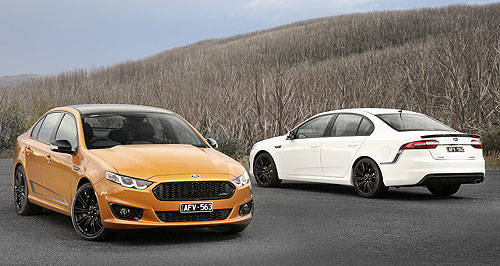News - Ford - Falcon - SprintFord protects FPV GT F legacy with SprintEight of the best: Ford's 5.0-litre supercharged V8’s 345kW occurs at 5750rpm, while its 575Nm kicks in between at a wide 2200-6250rpm band. Ford purposely placed the lower-priced XR Sprint range beneath FPV GT F swansong17 Mar 2016 PROTECTING the final FPV (Ford Performance Vehicles) GT F flagship’s status as the most powerful Falcon ever built dictated the powertrain changes undertaken for the new XR6 Turbo and XR8 Sprint. The last of the line, with production commencing in May, the FG X Falcon’s final act still produces healthy numbers, however, with Ford stating that these are the fastest XR series models ever produced. Nevertheless, with only very limited funds – Ford will not divulge what the exercise cost – it was decided from the beginning that the Sprint would not eclipse the GT F in terms of ultimate straight-line power and performance. Released in the middle of 2014 to see off the FPV sub-brand, the GT F delivers a startling standard power output of 351kW, rising to a reported 420kW in transient overboost mode in the right conditions. This compares to 325kW for the new XR6 Sprint (rising to 370kW in overboost) and 345kW for the XR8 Sprint (400kW in overboost). “With the V8, the key point was to create something unique and easily identifiable to the customer,” Ford Australia Sprint program manager Justin Capicchiano revealed. “The GT F was the pinnacle in regards to power, and we wanted to stay true to that commitment… so we created a new calibration to 345kW for the V8, with an overboost to 400kW and 650Nm.” As a result, the imported but locally modified 5.0-litre Eaton supercharged 32-valve V8’s 345kW occurs at 5750rpm, while its 575Nm kicks in between at a wide 2200-6250rpm band. The 420kW/650Nm overboost figures only last a few seconds, and only occurs if the intake air temperature conditions are correct. To help achieve such results, changes to the V8 include a new twin pedal map with a predictive system, while the old GT F’s ZF six-speed automatic transmission calibration was also utilised. Fuel consumption rises by 0.1 litre per 100km to 13.6 litres per 100km (manual) and 13.7L/100km (auto), averaging about 325 grams/km of carbon dioxide emissions. The XR6 Sprint’s in-line six, meanwhile, underwent a more thorough modification process – being made in Geelong, after all – with the regular XR6 Turbo’s 270kW/533Nm 4.0-litre twin-cam unit with variable valve timing gaining a number of changes. With a higher compression ratio (to 8.7:1 from 8.5:1), a redesigned lower airbox, larger carbon-fibre air intake, freer flowing exhaust, unique transmission calibration, bespoke engine calibration (including an engine-first launch control system, and GT F (V8) transmission mount (for improved handling characteristics), power is rated at 325kW (overboost: 370kW) at 6000rpm and the torque top is 576Nm (overboost: 650Nm) at 2750rpm. “The XR6 Sprint does not use the old F6 Turbo I6,” Mr Capicchiano said. “Except for the F6 turbocharger, injectors, and intercooler systems.” From there, new lower airbox, new larger carbon-fibre intake, free flowing exhaust, unique transmission calibration, bespoke engine calibration including launch control (for the first time in the automatic version of this car), GT F transmission mount (with handling benefits). Speaking of gearbox mounts, the ZF six-speed auto was sent to ZF in Germany for retuning now that it has to deal with significantly more torque, with new shift pressure scheduling, and easier and faster downshift ratio access the action is now crisper on the 1–2 and 2–3 up changes too, as the transmission had to be calibrated with the engine mods. XR6 Sprint consumption rises by 0.2 litre per 100km to 12.8L/100km, Ford says, averaging about 300 grams/km of carbon dioxide emissions. Of interest to Ford fans, the XR6 Sprint’s engine features unique badging, necessitating a new rocker cover to save money, the cast used to create the 1998-2002 AU Falcon XR6 VCT rocker cover was found and altered. With both engine choices, the Sprint brief call for a sizeable increase in midrange performance, as well as earlier low-range torque boost sensation, although the extra oomph is apparent across the entire rev range. “I think you’ll find that the top-end is extremely rapid the roll-on performance is really strong,” Mr Capicchiano added. The overboost function steps in after the minimum operating temperatures have been achieved, and will provide maximum possible power for up to 10 seconds before the engine protection strategy is engaged. It is worth remembering that while power outputs do fall, they never drop below the advertised standard output. The timer resets on gear change. Uniquely in the Ford world globally, the XR6 Sprint’s air intake system is made using four layers of carbon-fibre instead of the usual blow-moulded plastic, by the Geelong-based Quickstep Automotive, with engine engineering experts Premcar designing the item. The aim was to better response times by improving air flow and component strength, while cutting weight (by 46 per cent to 235 grams). “We were able to embrace new light-weighting technology as well as provide the best-possible efficiency of the system on our turbocharged XR6 Sprint,” according to Ford Australia vehicle line director David Wilkinson.  Read more17th of March 2016  Ford Falcon Sprint prioritises controlBest-ever handling and ride focus drove the dynamic signature of Ford Falcon Sprint17th of March 2016  Driven: 2016 Ford Falcon Sprint launches at lastFull details of the last Aussie Ford performance Falcon finally surface |
Click to shareFord articlesMotor industry news |
















Facebook Twitter Instagram